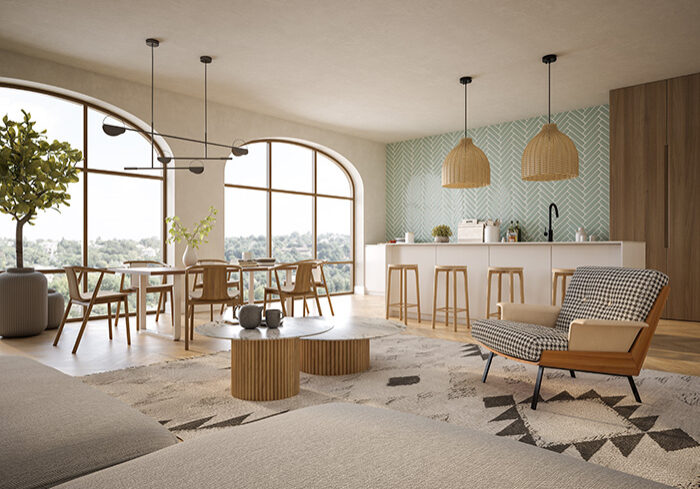Interior designers who want to make money with a blog need to understand the fundamentals of digital monetization strategies. A well-crafted blog brings a steady flow of organic traffic to your website. This means potential design clients discover you naturally through their searches, without you spending thousands on constant advertising campaigns!
Think about it—if you paused all your paid marketing efforts tomorrow, would your website still attract visitors? With a quality blog, it absolutely would! Your valuable content continues working for you 24/7, bringing in interested prospects even when you’re focused on your current design projects.
Your blog speaks directly to your ideal clients.By understanding exactly who you’re writing for, you can create content that addresses their specific challenges and aspirations, positioning yourself as the perfect solution to their needs.

Building A Strong Foundation
Before getting into monetization strategies, a solid foundation is essential if you want to make money with a blog in the competitive design industry. Just like how a beautiful interior needs solid structural elements before adding decorative touches, your blog requires key foundational elements to support profitable growth. Let’s look at the essential building blocks that will set you up for successful blog monetization.
Finding Your Design Niche
Before getting into monetization, you need a blog that attracts the right audience. Interior design is a broad field. Are you specializing in small space solutions, sustainable design, luxury homes, or commercial spaces? Narrowing your focus helps you stand out among the masses and attract readers who are specifically interested in your expertise.
For example, if you’re passionate about sustainable interior design, create content specifically addressing eco-friendly materials, energy-efficient layouts, and sustainable furniture sources. This targeted approach will attract readers who are genuinely interested in sustainable design, and who might be willing to pay for products or services in that niche.
Creating Content That Resonates
The foundation of a profitable blog is valuable content that your audience can’t find elsewhere. Consider what your ideal client is searching for:
- Step-by-step room transformation guides
- Design solutions for common problems (small spaces, awkward layouts)
- Budget-friendly design tips
- Seasonal decor ideas
- Design trend analyses and predictions
Content that solves problems or answers questions will keep readers coming back and sharing your posts with others. Remember to include stunning visuals—this is interior design, after all! High-quality photos of your projects or carefully selected stock images will make your content more engaging and shareable.
Optimizing for Search Engines
Even the most beautiful, informative blog won’t make money if no one can find it. Search engine optimization (SEO) is crucial for driving traffic to your interior design blog:
- Research keywords that potential clients might search for
- Include these keywords naturally in your titles, headings, and content
- Create descriptive, keyword-rich alt text for your images
- Ensure your website loads quickly and is mobile-friendly
- Build backlinks by guest posting on other design blogs or getting featured in online publications
“How often should I post?”
Aim for at least twice a month. But quality trumps quantity. The quality of your content matters more than quantity, though—one comprehensive, helpful post will perform better than several rushed, shallow ones. What questions are they frantically typing into Google late at night? Answer those questions with well-crafted, engaging blog posts.
6 Proven Blog Monetization Strategies
Now that you’ve built a solid foundation for your interior design blog, let’s look at the most effective ways to turn that traffic into income.
1. Recommend Products You Love
As an interior designer, you’re already recommending products to clients. Why not earn a commission when your blog readers purchase those same items? Affiliate marketing is one of the most accessible ways to make money with a blog, especially for interior designers who regularly recommend products.
How it works:
- Sign up for affiliate programs with retailers and brands you genuinely use and love (Amazon, Wayfair, West Elm, Anthropologie, etc.)
- Get unique tracking links to products
- Incorporate these links naturally into your content
- Earn a commission (typically 5-15%) when readers purchase through your links
Best practices:
- Only recommend products you’ve personally used or would confidently recommend to clients
- Be transparent about affiliate relationships (a simple disclosure at the beginning of posts with affiliate links is legally required and builds trust)
- Create helpful content formats like “10 Best Coffee Tables for Small Living Rooms” or “My Go-To Sources for Budget-Friendly Art” that naturally incorporate affiliate products
The most successful affiliate marketers in the interior design space focus on genuinely helpful recommendations rather than pushing products solely for commission. Your readers trust your design expertise. Maintain that trust by only promoting products you stand behind.
2. Passive Income Through Visibility
Google AdSense and other ad networks allow you to place advertisements on your blog and earn money when visitors view or click on these ads. While this is perhaps the most passive form of blog monetization, it requires significant traffic to generate meaningful income.
How to implement display advertising effectively:
- Start with Google AdSense, which is accessible to blogs of all sizes
- As your traffic grows, consider premium ad networks like Mediavine or AdThrive, which typically require minimum traffic thresholds but offer higher rates
- Place ads in non-intrusive locations that don’t detract from the user experience
- Limit yourself to 2-3 ad placements per post to maintain a professional appearance
For interior design blogs specifically, we recommend being selective about ad placement. Your blog represents your design aesthetic. Cluttering it with too many ads contradicts the clean, well-designed spaces you likely promote in your content.
3. Partner with Brands
As your blog grows, home decor brands, furniture companies, and other design-related businesses may approach you to create sponsored content featuring their products. This can be a lucrative opportunity that aligns perfectly with your existing content.
Types of sponsored content for interior design blogs:
- Room makeovers using a brand’s products
- DIY projects featuring specific materials or tools
- “How I styled this [brand] piece three different ways”
- Behind-the-scenes looks at furniture manufacturing or design processes
Keys to successful sponsored content:
- Partner only with brands that align with your aesthetic and values
- Maintain your authentic voice and style
- Be upfront about sponsored relationships
- Charge what you’re worth—sponsored posts from established design bloggers can command $500-$5,000+ depending on your reach and engagement
When negotiating sponsored content rates, consider not just your traffic but the quality of your audience. Interior design blogs often attract readers with disposable income and immediate interest in home products, making your platform particularly valuable to relevant brands.
4. Share Your Expertise
Your design knowledge is valuable. Creating and selling digital products is a scalable way to make money with a blog without requiring ongoing time investment.
Digital product ideas for interior designers:
- Room design templates or planners
- Furniture arrangement guides for different room shapes
- Color palette collections
- Design style quizzes with personalized recommendations
- E-books on specialized topics (kid-friendly design, pet-proof decorating, etc.)
- Printable art or design elements
Digital products can range from simple $7 downloadable guides to comprehensive $97+ e-courses. The key is creating something that provides immediate value and helps your audience solve a specific design challenge.
5. Teach Your Skills
Take your expertise beyond static downloads by creating interactive learning experiences. Online courses allow you to charge premium prices while sharing your specialized knowledge.
Course topics that sell well for interior designers:
- “Design Your Home Office for Maximum Productivity”
- “How to Create a Cohesive Design Throughout Your Home”
- “Refresh Your Space on a Budget”
- “Master Class: Room Layout Fundamentals”
- “Finding Your Personal Design Style”
You can host courses on platforms like Teachable or Thinkific, or create live workshop experiences via Zoom. The most successful courses include video demonstrations, workbooks, and some form of community or feedback.
6. Convert Readers to Clients
Your blog is the perfect platform for showcasing your expertise and converting readers into paying design clients. Offer specialized consultation services that give readers a taste of what it’s like to work with you.
Consultation offerings to promote on your blog:
- 45-minute virtual design consultations (like Logistis for Designers’ free consultation offering)
- DIY design reviews where clients share photos and you provide feedback
- Shopping services where you curate product recommendations for specific spaces
- Color consultation sessions
Make booking easy by integrating a scheduling tool directly into your blog, and consider creating a special offer exclusively for blog readers to encourage conversions.
Using Social Media to Amplify Your Blog
Your blog and social media should work together as part of a cohesive marketing strategy. Use platforms like Instagram, Pinterest, and Houzz to drive traffic to your monetized blog content.
Social media strategies for interior design bloggers:
- Create Pinterest-optimized graphics for each blog post
- Share before/after snippets on Instagram with a link to the full project blog
- Repurpose blog content into carousel posts, short videos, or Instagram guides
- Use Instagram Stories to share daily design inspiration with “swipe up” links to related blog posts (or the link sticker if you have fewer than 10,000 followers)
Remember that each platform serves a different purpose. Pinterest drives long-term traffic, Instagram builds community and personal connection, and Houzz helps you connect with potential clients actively planning design projects.
Legal and Financial Considerations
As you monetize your blog, keep these important considerations in mind:
- Disclosure requirements: The FTC requires clear disclosure of affiliate relationships and sponsored content. Include statements like “This post contains affiliate links” or “This post is sponsored by [brand]” prominently in your content.
- Tax implications: Income from your blog is taxable. Keep detailed records of revenue and expenses, and consider consulting with a financial advisor familiar with creative businesses (like Logistis for Designers, which specializes in working with interior designers). The IRS has specific requirements for reporting blog income, and our CFO services can help ensure you’re maximizing deductions while staying compliant.
- Separate accounts: Consider setting up dedicated accounts for blog income to simplify accounting and tax preparation.
- Contracts: Always use contracts for sponsored content that clearly outline deliverables, payment terms, and usage rights.
Your Blog as a Revenue Engine
Your interior design blog isn’t just a marketing tool. It’s a potential business in itself. By implementing the monetization strategies we’ve outlined, you can create multiple revenue streams that complement your design services and provide income stability.
The most successful design bloggers take a strategic approach, focusing on creating exceptional content first and then thoughtfully integrating monetization methods that enhance rather than detract from the reader experience.
With consistency and strategic planning, you can make money with a blog while simultaneously growing your interior design business. Start with one or two monetization methods that feel most aligned with your business goals, perfect those, and then expand. With patience and persistence, your interior design blog can become a significant source of both clients and direct income.
Ready to take your interior design business finances to the next level? Schedule a free 45-minute consultation with our team at Logistis for Designers. We specialize in helping interior designers build profitable businesses through smart financial management.
FAQs
How quickly can I make money with a blog in the interior design niche?
Most design blogs take 6-12 months of consistent posting before generating meaningful income. Focus on building quality content and growing your audience before expecting significant revenue.
How much money can I make from my interior design blog?
Income varies widely. Successful interior design bloggers earn anywhere from a few hundred dollars monthly to six figures annually, depending on traffic, monetization strategies, and audience engagement.
Do I need a large following to monetize my blog?
Not necessarily. A smaller, highly engaged audience interested in interior design can be more valuable than a large but disinterested following, especially for affiliate marketing and digital products.
Which monetization method should I start with?
Affiliate marketing is often the easiest starting point for interior design blogs since you’re already recommending products. It requires minimal setup while using your existing content.
Is it better to focus on my blog or social media?
Both work together. Your blog provides in-depth content and monetization opportunities, while social media expands your reach and drives traffic to your blog. Prioritize your blog for long-term value.
Do I need to disclose affiliate links on my design blog?
Yes, it’s legally required by the FTC to disclose affiliate relationships. A simple statement at the beginning of posts with affiliate links is sufficient and builds trust with readers.
How often should I post new content to monetize effectively?
Quality trumps quantity. For interior design blogs, 2-4 high-quality posts monthly with beautiful visuals will outperform frequent but shallow content.
Share On:



